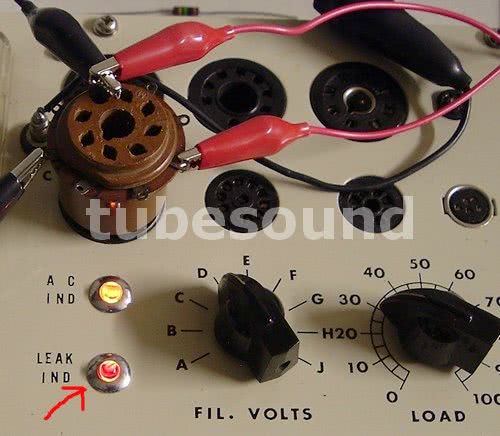This article will discuss servicing of the Lafayette TE-50 tube tester. Electrical voltages are present, repairs should only be attempted by a qualified technician. Copyrighted, all rights reserved. Ebay ID = rjputnak

The Lafayette TE-50 is an excellent example of a nice portable tube tester that packs a lot of punch into a very small package. Measuring only 10 x 9 x 4 inches and weighing approx 6-lbs, you have a tube tester that can be easily taken on the road, while at home, it only occupies a small bench area. The instruction manual, tube charts, and substitute chart are attached to a drawer that tucks away neatly inside the tester. (The drawer handle is NOT a carry handle!) The all-metal chassis is very durable. A black fabric carry case with handles was also supplied.


Do you need paperwork for your Lafayette TE-50 tube tester?
We sell a remastered paperwork for Lafayette TE-50, consisting of Operating Instructions, Troubleshooting section, Machine Schematic, Standard Tube Chart, Supplemental Tube Chart, Additional Supplement included for Compactron, Novar, and HAM Sweep tubes (ie – 6LF6, 6LQ6, 6JB6, 6KD6, etc…), Tube Interchange Chart (ie – a tube substitute chart).
All for $12 free ship USA

The TE-50 uses a traditional Emission test circuit, along with Leakage and Shorts detection. The leakage circuit is factory-set at 2-Megohms (2.2 Meg resistor across the neon leakage lamp), which means it will detect inter-element leakage from 0 (solid short) up to 2 Megohms. More tube leakage = brighter lamp glow (more = lower number resistance approaching Zero, with zero being a complete Short). Of course, by changing the value of this resistor you can change the detection sensitivity. The instructions carefully explain that some tubes will show leakage at this 2 Megohm sensitivity, because this sensitivity is very stringent. Many tube testers set this sensitivity at 1-Megohm as a more conservative setting, but since 2 Meg is much more sensitive, it will detect even very slight leakage. This is good, assuming that you understand that a dim leakage glow is not necessarily something to be concerned about.
The TE-50 has a modern compliment of eight sockets: Octal, Loctal, 9-pin miniature, 7-pin miniature, 8-pin sub-mini, Nuvistor, 9-pin Novar, 12-pin Compactron. This means that the tester is suited for people working on post-1950s tube equipment, including guitar amps, HAM radio rigs, 1950-1960’s jukeboxes, etc. Since the tester does not have the very old sockets (4-pin, 5-pin, etc.), this model is not suitable for early antique radio servicing (1920’s to 1940’s).
Servicing is straightforward. Clean all switches, sockets, and Load potentiometer with DeoxIT. Check every resistor for correct resistance. The tester contains two capacitors; check them and replace if necessary. I find that the .01uF cap is almost always defective, and should be replaced. Symptoms of a defective .01uF cap are easy to spot — the Leakage lamp will always light when checking for Leakage/Shorts. Check all voltages, including each filament position.
Leakage and Shorts can be checked by using a Test Socket, a pair of jumper wires, and a 1-megohm resistor.

In the photo above, I am using an Octal Test socket. A pair of jumper wires connect a 1-meg resistor between pins 3 and 8. With the test switch set to “LEAK”, when moving either switch 3 or switch 8 from K up to P position, you will see a moderate glow on the Leak lamp. If you were to use a 2-Meg resistor, you would see either a very dim glow or a slight flicker of glow.
Similarly, if you jumper those pins together (instead of connecting them thru a resistor), you can simulate an internal tube short as follows:

(Notice the brighter glow of the Leak lamp when testing a Short vs. Leakage).
The tester is designed to test new tubes in the center of the Green-Good area, therefore “100” does NOT mean ‘perfect new’ on this unit. The 0 to 100 scale is simply used to compare the relative emission of similar tube types. In fact, a normal good tube will never read full scale. (Read Page 8 of the manual if you are ever confused about this point).
Overall, an excellent choice for a anyone wanting a simple-to-use, portable tube tester, that even has the capability to test novar & compactron sweep tubes.
FINAL THOUGHTS
Pros:
- Small size and light weight. Perfect for small workbenches and technicians/musicians on-the-go.
- Easy to use.
- Effective shorts test.
- All metal construction = solid and durable.
- Sockets to test compactron and novar tubes.
- Tube chart and instruction book tuck away neatly inside the tester.
- Solid-state design (no internal tubes) generally means better reliability (less maintenance) than testers with tubes in their circuitry.
Cons:
- No sockets for testing antique (1920-1930s) tubes, such as 4-pin, 5-pin, 6-pin, 7-pin large, acorn, etc. Therefore, it would not be suitable for antique radio collectors. Of course, this is the trade-off for its small size and light weight; the tester would have to be much larger to accommodate all those additional sockets, and many people would never use those sockets anyway.
- Test method not as sophisticated as larger, more complex, testers (such as a Hickok.)
- It would be nice if the leakage test was adjustable on-the-fly. Unfortunately, adjustable leakage control is not a very common feature (usually not found even on $500-$1,000 testers), and in practice would not add any functionality for most users anyway. That said, you could modify the leakage test circuit to add this functionality if desired.
- Tester is not fused to protect the transformer. (Of course, you could easily add a line fuse if desired.)
regards,
Bob Putnak
eBay ID = rjputnak
